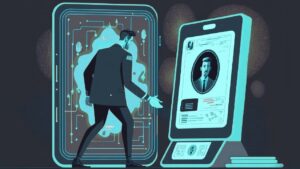Introduction
As the traditional reliance on passwords and PINs proves increasingly susceptible to breaches, the future of authentication finds a promising ally in biometrics. The fusion of technology and biology, biometric authentication harnesses unique physiological and behavioral markers to verify an individual’s identity. From fingerprints and facial recognition to iris scans and voiceprints, biometrics introduces a dynamic and multifaceted approach to authentication that promises not only heightened security but also a seamless user experience.
This exploration delves into the unfolding narrative of Biometrics and the future of Authentication.” It navigates the diverse modalities of biomatrics, from established methods to emerging innovations, painting a portrait of a future where access to our digital realms is as personal as our fingerprints and as unique as our faces. Beyond the immediate horizon, the narrative explores the trajectory of biometric technology in fostering a secure, continuous, and frictionless authentication experiences.
Exploring biometrics modalities
- Biometrics Modalities: A Diverse Array:
- The future of authentication is not confined to a single biometric modality. Instead, it embraces a diverse array of biometric markers, ranging from fingerprint and facial recognition to iris scans, and even behavioral biometrics like keystroke dynamics and gait analysis. This multi-modal approach enhances accuracy, resilience, and adaptability, ensuring a robust defense against unauthorized access.
- Seamless and Frictionless User Experience:
- One of the defining features of biometric authentication is its ability to provide a seamless and frictionless user experience. Future systems are expected to further streamline this process, eliminating the need for passwords or PINs. The simple act of looking into a camera, providing a fingerprint, or speaking a passphrase becomes the gateway to secure digital interactions.
- Ubiquity Across Industries:
- As the technology matures, biometric authentication is set to become ubiquitous across various industries. From unlocking smartphones and accessing bank accounts to securing smart homes and validating identities at airports, biometrics will play a central role in creating a cohesive and integrated authentication ecosystem.
- Continuous authentication for ongoing security:
- The future extends beyond static, one-time authentication events. Continuous authentication, where a user’s identity is verified throughout the entire duration of their interaction with a system, emerges as a proactive defense mechanism. Behavioral biometrics, such as typing patterns or mouse movements, contribute to a dynamic and ongoing authentication process.
- Security and Privacy Concerns:
- While the advantages of biometric authentication are evident, the future will also grapple with addressing security and privacy concerns. Striking the right balance between robust security measures and protecting individuals’ privacy will be a key challenge. Secure storage of biometric data, adherence to privacy regulations, and implementation of ethical practices will be crucial considerations.
- Emergence of Biometric Wearable:
- The integration of biometrics into wearable devices adds another layer of innovation to the authentication landscape. Smart watches, fitness trackers, and other wearable equipped with biometric sensors offer users a convenient and unobtrusive way to authenticate themselves, further blurring the lines between technology and daily life.
- AI and Machine Learning Enhancements:

- The future evolution of biometric authentication will witness enhancements driven by artificial intelligence (AI) and machine learning (ML). These technologies will not only improve the accuracy of biometric systems but also enable them to adapt to changes over time, ensuring reliable performance in various conditions.
Here are some prominent types of biometrics shaping the future of authentication
- Fingerprint Recognition: Analyzing the unique patterns of ridges and valleys on an individual’s fingertips. Continues to be a widely used and evolving biometric modality, with applications ranging from smartphones to secure access control.
- Facial Recognition: Capturing and analyzing unique facial features, such as the distance between eyes, nose, and mouth. Ubiquitous in smartphones and security systems, with potential expansions into retail, healthcare, and public safety.
- Iris Scanning: Examining the unique patterns in the iris of the eye. Offers a high level of accuracy and is anticipated to be used in secure access systems and border control.
- Voice Recognition: Analyzing the unique vocal characteristics, including pitch, tone, and cadence. Widely used in telephone-based authentication and expected to expand into voice-activated devices and secure communication channels.
- DNA Biometrics: Analyzing unique genetic markers in an individual’s DNA. A cutting-edge area with potential applications in forensic science and highly secure identity verification.
- Heartbeat Biometrics: Analyzing the unique patterns in an individual’s heartbeat. Emerging as a potential continuous authentication method in wearable devices and healthcare applications.
- Brainwave Authentication: Analyzing unique brainwave patterns through electroencephalography (EEG). Experimental but holds potential for secure access and medical applications.
- Facial Thermography: Analyzing the thermal patterns of the face. Potential applications in health monitoring and security, with the ability to detect anomalies in temperature.
Conclusion
In the future of authentication, biometrics stands as a beacon of innovation, providing a secure, user-friendly, and adaptable approach to identity verification. As we embrace this transformation, the convergence of diverse biometric modalities, seamless user experiences, continuous authentication, and ethical considerations will collectively shape a landscape where proving our digital identity becomes as natural as a fingerprint or a glance. The journey toward the future of authentication is guided by the principles of security, convenience, and a commitment to safeguarding the digital realms we navigate.

